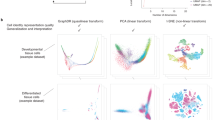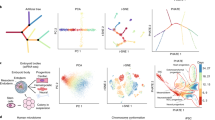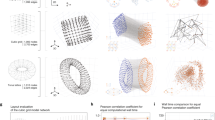Abstract
The detailed structure of molecular networks, including their dependence on conditions and time, are now routinely assayed by various experimental techniques. Visualization is a vital aid in integrating and interpreting such data. We describe emerging approaches for representing and visualizing systems data and for achieving semantic zooming, or changes in information density concordant with scale. A central challenge is to move beyond the display of a static network to visualizations of networks as a function of time, space and cell state, which capture the adaptability of the cell. We consider approaches for representing the role of protein complexes in the cell cycle, displaying modules of metabolism in a hierarchical format, integrating experimental interaction data with structured vocabularies such as Gene Ontology categories and representing conserved interactions among orthologous groups of genes.
This is a preview of subscription content, access via your institution
Access options
Subscribe to this journal
Receive 12 print issues and online access
$209.00 per year
only $17.42 per issue
Buy this article
- Purchase on Springer Link
- Instant access to full article PDF
Prices may be subject to local taxes which are calculated during checkout







Similar content being viewed by others
References
DeRisi, J.L., Iyer, V.R. & Brown, P.O. Exploring the metabolic and genetic control of gene expression on a genomic scale. Science 278, 680–686 (1997).
Lashkari, D.A. et al. Yeast microarrays for genome wide parallel genetic and gene expression analysis. Proc. Natl. Acad. Sci. USA 94, 13057–13062 (1997).
MacBeath, G. Protein microarrays and proteomics. Nat. Genet. 32 (suppl. 2), 526–532 (2002).
Davy, A. et al. A protein-protein interaction map of the Caenorhabditis elegans 26S proteasome. EMBO Rep. 2, 821–828 (2001).
Ito, T. et al. Toward a protein-protein interaction map of the budding yeast: a comprehensive system to examine two-hybrid interactions in all possible combinations between the yeast proteins. Proc. Natl. Acad. Sci. USA 97, 1143–1147 (2000).
Rain, J.C. et al. The protein-protein interaction map of Helicobacter pylori. Nature 409, 211–215 (2001).
Rual, J.F. et al. Toward a proteome-scale map of the human protein-protein interaction network. Nature 437, 1173–1178 (2005).
Bimbo, A. et al. Systematic deletion analysis of fission yeast protein kinases. Eukaryot. Cell 4, 799–813 (2005).
Parks, A.L. et al. Systematic generation of high-resolution deletion coverage of the Drosophila melanogaster genome. Nat. Genet. 36, 288–292 (2004).
Tong, A.H. et al. Systematic genetic analysis with ordered arrays of yeast deletion mutants. Science 294, 2364–2368 (2001).
Gitton, Y. et al. A gene expression map of human chromosome 21 orthologs in the mouse. Nature 420, 586–590 (2002).
Kim, S.K. et al. A gene expression map for Caenorhabditis elegans. Science 293, 2087–2092 (2001).
Gunsalus, K.C. et al. Predictive models of molecular machines involved in Caenorhabditis elegans early embryogenesis. Nature 436, 861–865 (2005).
Oltvai, Z.N. & Barabasi, A.L. Systems biology. Life's complexity pyramid. Science 298, 763–764 (2002).
Prinz, S. et al. Control of yeast filamentous-form growth by modules in an integrated molecular network. Genome Res. 14, 380–390 (2004).
Spirin, V. & Mirny, L.A. Protein complexes and functional modules in molecular networks. Proc. Natl. Acad. Sci. USA 100, 12123–12128 (2003).
Hartwell, L.H., Hopfield, J.J., Leibler, S. & Murray, A.W. From molecular to modular cell biology. Nature 402, C47–C52 (1999).
Rives, A.W. & Galitski, T. Modular organization of cellular networks. Proc. Natl. Acad. Sci. USA 100, 1128–1133 (2003).
Ravasz, E., Somera, A.L., Mongru, D.A., Oltvai, Z.N. & Barabasi, A.L. Hierarchical organization of modularity in metabolic networks. Science 297, 1551–1555 (2002).
Endy, D. & Brent, R. Modelling cellular behavior. Nature 409, 391–395 (2001).
Ashburner, M. et al. Gene ontology: tool for the unification of biology. Nat. Genet. 25, 25–29 (2000).
Demir, E. et al. An ontology for collaborative construction and analysis of cellular pathways. Bioinformatics 20, 349–356 (2004).
Fukuda, K. & Takagi, T. Knowledge representation of signal transduction pathways. Bioinformatics 17, 829–837 (2001).
Breitkreutz, B.J., Stark, C. & Tyers, M. Osprey: a network visualization system. Genome Biol. 4, R22 (2003).
Shannon, P. et al. Cytoscape: a software environment for integrated models of biomolecular interaction networks. Genome Res. 13, 2498–2504 (2003).
Kohn, K.W. & Aladjem, M.I. Circuit diagrams for biological networks. Mol. Syst. Biol. [online] 2, 2006.0002 (2006).
Kitano, H., Funahashi, A., Matsuoka, Y. & Oda, K. Using process diagrams for the graphical representation of biological networks. Nat. Biotechnol. 23, 961–966 (2005).
Hucka, M. et al. The systems biology markup language (SBML): a medium for representation and exchange of biochemical network models. Bioinformatics 19, 524–531 (2003).
Sugiyama, K. & Misue, K. Visualization of structure information: automatic drawing of compound digraphs. IEEE Trans. Syst. Man Cybern. 21, 876–892 (1991).
Berge, C. Graphs and hypergraphs 2nd rev. edn. (Elsevier North-Holland, New York, 1976).
Lee, T.I. et al. Transcriptional regulatory networks in Saccharomyces cerevisiae. Science 298, 799–804 (2002).
Milo, R. et al. Network motifs: simple building blocks of complex networks. Science 298, 824–827 (2002).
Herman, I., Melanç on, G. & Marshall, S.M. Graph visualization and navigation in information visualization: a survey. IEEE Trans. on Visualization and Computer Graphics 6, 24–43 (2000).
Stamm, S. Signals and their transduction pathways regulating alternative splicing: a new dimension of the human genome. Hum. Mol. Genet. 11, 2409–2416 (2002).
Boulos, M.N. The use of interactive graphical maps for browsing medical/health Internet information resources. Int. J. Health Geogr. [online] 2, 1 (2003).
Stuart, J.M., Segal, E., Koller, D. & Kim, S.K. A gene-coexpression network for global discovery of conserved genetic modules. Science 302, 249–255 (2003).
Zhang, L.V. et al. Motifs, themes and thematic maps of an integrated Saccharomyces cerevisiae interaction network. J. Biol. 4, 6 (2005).
Fraser, A.G. & Marcotte, E.M. A probabilistic view of gene function. Nat. Genet. 36, 559–564 (2004).
Guimera, R. & Nunes Amaral, L.A. Functional cartography of complex metabolic networks. Nature 433, 895–900 (2005).
Ihmels, J. et al. Revealing modular organization in the yeast transcriptional network. Nat. Genet. 31, 370–377 (2002).
Bar-Joseph, Z. et al. Computational discovery of gene modules and regulatory networks. Nat. Biotechnol. 21, 1337–1342 (2003).
Wu, J., Hu, Z. & DeLisi, C. Gene annotation and network inference by phylogenetic profiling. BMC Bioinformatics [online] 7, 80 (2006).
D'Amours, D. & Jackson, S.P. The Mre11 complex: at the crossroads of DNA repair and checkpoint signaling. Nat. Rev. Mol. Cell Biol. 3, 317–327 (2002).
Kohn, K.W. Molecular interaction maps as information organizers and simulation guides. Chaos 11, 84–97 (2001).
Kohn, K.W., Aladjem, M.I., Weinstein, J.N. & Pommier, Y. Molecular interaction maps of bioregulatory networks: a general rubric for systems biology. Mol. Biol. Cell 17, 1–13 (2006).
Kohn, K.W., Aladjem, M.I., Kim, S., Weinstein, J.N. & Pommier, Y. Depicting combinatorial complexity with the molecular interaction map notation. Mol. Syst. Biol. [online] 2, 51 (2006).
Blinov, M.L., Faeder, J.R., Goldstein, B. & Hlavacek, W.S. A network model of early events in epidermal growth factor receptor signaling that accounts for combinatorial complexity. Biosystems 83, 136–151 (2006).
Zanzoni, A. et al. MINT: a Molecular INTeraction database. FEBS Lett. 513, 135–140 (2002).
Noy, N.F. et al. Protege-2000: an open-source ontology-development and knowledge-acquisition environment. AMIA Annu. Symp. Proc. 953 (2003).
Joshi-Tope, G. et al. Reactome: a knowledgebase of biological pathways. Nucleic Acids Res. [online] 33, D428–D432 (2005).
Yu, H. et al. Annotation transfer between genomes: protein-protein interologs and protein-DNA regulogs. Genome Res. 14, 1107–1118 (2004).
Kelley, B.P. et al. PathBLAST: a tool for alignment of protein interaction networks. Nucleic Acids Res. [online] 32, W83–W88 (2004).
Tatusov, R.L. et al. The COG database: an updated version includes eukaryotes. BMC Bioinformatics [online] 4, 41 (2003).
Saraiya, P., North, C. & Duca, K. Visualizing biological pathways: requirements analysis, systems evaluation and research agenda. Information Visualization 1, 15 (2005).
Hu, Z. et al. VisANT: data-integrating visual framework for biological networks and modules. Nucleic Acids Res. [online] 33, W352–W357 (2005).
Demir, E. et al. PATIKA: an integrated visual environment for collaborative construction and analysis of cellular pathways. Bioinformatics 18, 996–1003 (2002).
Kanehisa, M., Goto, S., Kawashima, S. & Nakaya, A. The KEGG databases at GenomeNet. Nucleic Acids Res. 30, 42–46 (2002).
Andrews, B. & Measday, V. The cyclin family of budding yeast: abundant use of a good idea. Trends Genet. 14, 66–72 (1998).
Gavin, A.C. et al. Functional organization of the yeast proteome by systematic analysis of protein complexes. Nature 415, 141–147 (2002).
Hu, Z., Mellor, J., Wu, J. & DeLisi, C. VisANT: an online visualization and analysis tool for biological interaction data. BMC Bioinformatics [online] 5, 17 (2004).
Cherry, J.M. et al. SGD: Saccharomyces Genome Database. Nucleic Acids Res. 26, 73–79 (1998).
Mellor, J.C., Yanai, I., Clodfelter, K.H., Mintseris, J. & DeLisi, C. Predictome: a database of putative functional links between proteins. Nucleic Acids Res. 30, 306–309 (2002).
Author information
Authors and Affiliations
Corresponding author
Ethics declarations
Competing interests
The authors declare no competing financial interests.
Supplementary information
Rights and permissions
About this article
Cite this article
Hu, Z., Mellor, J., Wu, J. et al. Towards zoomable multidimensional maps of the cell. Nat Biotechnol 25, 547–554 (2007). https://doi.org/10.1038/nbt1304
Published:
Issue Date:
DOI: https://doi.org/10.1038/nbt1304
This article is cited by
-
Heuristic shortest hyperpaths in cell signaling hypergraphs
Algorithms for Molecular Biology (2022)
-
Extended LineSets: a visualization technique for the interactive inspection of biological pathways
BMC Proceedings (2015)
-
Mimoza: web-based semantic zooming and navigation in metabolic networks
BMC Systems Biology (2015)
-
NaviCell: a web-based environment for navigation, curation and maintenance of large molecular interaction maps
BMC Systems Biology (2013)
-
Visualization of omics data for systems biology
Nature Methods (2010)



